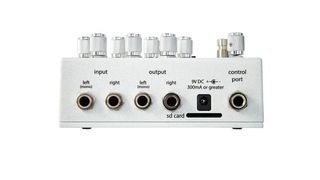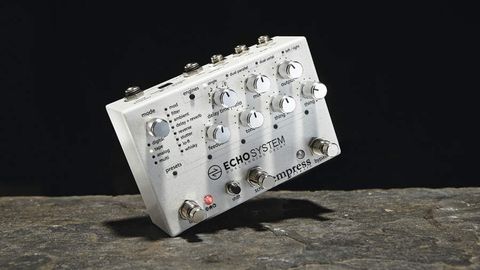With the same form as the Empress reverb that debuted in 2016, the Echosystem aims to provide all the delay and echo sounds you could possibly need without eating up too much of your valuable pedalboard space.
Capable of various mono and stereo operation modes, the pedal features two separate delay engines which can be used singly or together, routed in parallel, in series or in mono out of separate outputs. Each delay engine has a choice 12 algorithm modes and a range of sub- modes; Tape, for example, has New Tape, Old Tape, Echoplex and Space Echo.
In Use
You scroll through the modes with the Rotary mode switch, although the lack of a display means you have to refer to the manual to see which does what. Once you’ve selected your mode(s) there are a range of tweaks to set up your sound using the knobs. Mix, Output, Feedback and Tone knobs are standard but there are also the Thing1 and Thing2 knobs that adjust a different function for each mode. Delay time can be set by knob or a tap tempo footswitch with a choice of timing ratios.
Single delays are easy to set up and tweak on the fly, but for the more complex stuff you’ll be glad to know that the pedal can store up to 35 user presets. Without a display for numbered presets you may wonder how practical it is to identify and call them up, but the Empress system has a certain logic to it.

Five LEDs represent the five presets in each of the seven banks and each bank assigns a different colour to the LEDs. Hitting the middle (Scroll) footswitch scrolls through presets and banks in order and you make your chosen preset active by hitting the Tap footswitch.
There’s also a Bank mode that allows instant footswitch access to two presets (or three if you add an external tap switch). A Control Port jack allows an expression pedal to control as many parameters as you want simultaneously and can also be configured to take CV signals, an external tap switch or MIDI control. Further foot-controlled expression comes with holding down the Tap switch for infinite repeats.
Sounds
Getting familiar with the Echosystem’s operation might take a little time but it’s all worth it for the superb range of sounds that it can conjure up. There is so much variety on offer from pristine digital delays through accurate sounding emulations of tape and BBD devices, to filtered and specifically Lo-Fi sounds.
Then you have the more off-the-wall types liked chopped and stuttering repeats and Whisky mode with its pitched delays. Fans of huge spacey sounds may gravitate to the four specified ambient modes or those that feature reverb and delay in combination.
The only thing missing is a looper but apparently there’s one on the way with a firmware upgrade. Things really get most interesting when you select dual mode operation, as you can layer and synchronise different modes for complex rhythmic repeats, massive ambient soundscapes or some really wacky stuff if that’s your inclination. With two different delays working together, the sonic potential is enormous.
Is the EchoSystem for you? Well, that depends how deep you want to get into delay. If you just want a simple bit of echo now and again to spice things up then probably not.
However, if are the sort of player that’s coveted a Strymon TimeLine or similar and could integrate a range of complex delays into your playing for ambience and texture then this hits the mark.
This is a not only a pedal that can provide all the standard delays you are likely to want or need but it also has a virtuosity that stretches much further, encouraging creativity by using two engines to craft your own unique delay combinations.
A display for preset numbers, exact delay times in milliseconds and precise recall of parameter values might be on the wishlist of some delay users, but the other side of the coin is that what you are getting here is completely hands-on, instantly accessible, on the surface and not hidden away in menus.

